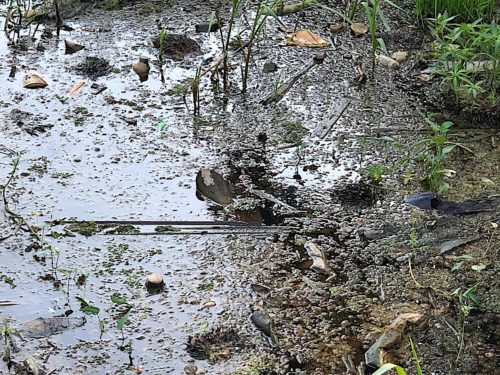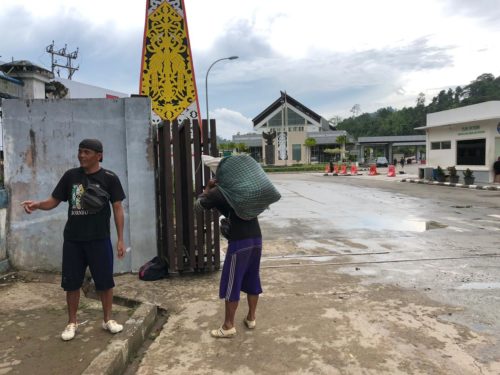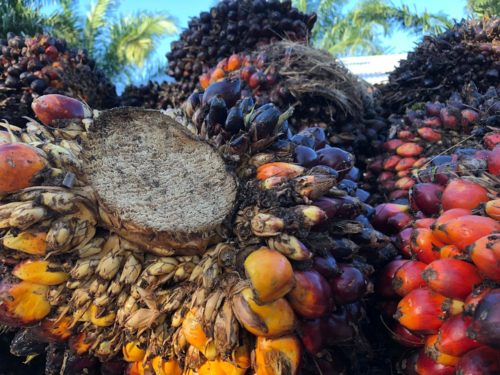You will never read about it, but Dayak people, the “First Nation” of the enormous island of Borneo, are broken, robbed and brainwashed.
“Unity in diversity” it says; the motto of Indonesia. But it could be argued that the opposite is true. There is very little unity, and less and less diversity, as the country is controlled from Jakarta, an enormous, overpopulated stinky and sinking megapolis which is located on the island of Java.
Jakarta does not want to allow any dissent. For half a century it has made sure that everyone on this huge and unfortunate archipelago thinks the same, while desiring no improvement. Here, everyone is religious, everyone anti-Communist and fanatically pro-capitalist. The result is: the country collapsed, a long time ago, but ‘no one noticed’. While the Western media is paid ‘not to notice’.
“It is a modern-time colonialism”, I heard thousands of times. Java is perceived by many who are living on those proverbial thousands of islands (the Indonesian archipelago has over 17 thousand isles which are spread over a great area), as a colonialist, aggressive and morally corrupt entity. No wonder: after independence from Netherlands, the country was formed, generally, along the old colonial boundaries.
During the era of the progressive anti-imperialist President Ahmed Sukarno, Indonesia was at least a co-founder of the Non-aligned Movement. It nationalized its natural resources, while building an enlightened socialist motherland.
That did not last very long. Following the West-sponsored brutal military coup of 1965, socialism was destroyed, Communists and atheists murdered, and the US-style neo-colonialist rule managed to smash all hopes for a better future.
Ever since, most of the islands have been run as colonies: pillaged, and oppressed. The ‘transmigration’ policy has been turning local people into a minority, at least in the various ‘strategic’ areas. Those have literally been flooded with state-sponsored immigrants from Java, Southern Sumatra, and other densely-populated Sunni Muslim parts of the country.
Modern-day Indonesia has lived through three cruel genocides in its modern history: one triggered during and after the fascist coup (1965/66), then one that was perpetrated in (formerly) occupied East Timor, and the one, on-going one, in the conquered West Papua. But that is not all: terrible inter-ethnic and inter-religious conflicts have been shaking Indonesia for decades: from Aceh to Sulawesi, Ambon, Kalimantan (Borneo), to name just a few. Anti-Chinese pogroms have been common for centuries.
If there were to be a referendum, most of the islands, including the tourist island of Bali, would opt for independence. But that is a hushed fact, as it would never be allowed. The unproductive and depressingly over-populated island of Java virtually lives off the plundering of the riches of the entire archipelago. Indonesia’s ‘wealth’ mainly comes from commodities; from unbridled plundering of the outer islands.
 Polluted waterways of Kalimantan
Polluted waterways of Kalimantan
That, of course, is true about one of the biggest booty – the enormous Kalimantan.
Many of the filthy rich Javanese families are connected to the plunder. Their wealth comes directly from destruction of the archipelago. The five-star hotels surrounded by Jakarta’s slums, malls with overpriced European brand names, and tasteless villas in gated communities, are built on blood and robbery.
*****
The island of Borneo is the third largest island on earth, after Greenland and Papua. It is shared by Indonesia (where it is known as Kalimantan), and also by Malaysia and Brunei Darussalam. And it has, or more precisely, it used to count on all kinds of imaginable treasures, from oil to coal, gold, uranium and timber.
 Entering Indonesian Kalimantan from Malaysia
Entering Indonesian Kalimantan from Malaysia
It also used to be one of the most pristine and stunning parts of the world, covered by plush native forests, which grew all along the mighty and clean tropical waterways.
Borneo’s native people, the Dayaks, used to live in true symbiosis with nature. Whatever their internal problems were, they never tried to conquer other islands.
But this self-contained paradise had been brutally penetrated and eventually destroyed; first by the Dutch colonialists, and later by the legendary Javanese greed united with Western multi-national companies.
Today, Borneo, or at least its Indonesian part, is almost entirely ruined. Most of its forests have been cut down, giving way to the endless and toxic oil palm plantations. Rivers where gold is being mined both legally and illegally, are poisoned by mercury, while entire mountains are levelled by local and foreign mining companies. Coal mines are of tremendous proportions, and expanding.
The wisdom of the local people is still alive, but only deep in what is left of the native forests. Most of the ‘modern-day’ Dayak people have been cannily incorporated by the regime into the system which thrives on plundering of the land and of all that nature holds above and below the surface.
*****
Mr. Krisusandi, the chief of “Dayakology Institute” located in the city of Pontianak, West Kalimantan, does not hide his frustration, when he sits across the table from us, in his office:
West Kalimantan has more than 150 ethnic groups of Dayaks. Each has its own language and culture… and that’s only in the area of West Kalimantan! To call them all by the same name – Dayak – is derogatory, inaccurate.
Local people used to inhabit some of the richest lands on earth, in terms of natural resources,” I suggest. Mr. Krisusandi agrees:
Precisely. And this is precisely the curse; the key to understanding why, compared to other indigenous societies, the oppression of Dayaks is the worst.
During Suharto’s ‘New Order’, the regime developed stigmas and stereotypes, belittling and humiliating Dayaks; like that they are ‘backward’, ‘primitive’ and ‘uncivilized’. The military, the fascists, got used to judging Dayaks as forest dwellers and destroyers. The result: Dayak society got discriminated against, losing its culture, independence, and even began feeling shame for being what it is.
Because of that shame, Dayaks have been lulled into converting to Islam, or to Christianity. And after that, they were not Dayaks, anymore! Consequently, they were forced to accept the centralized education system, which has been totally ignoring the local knowledge.
That was, of course, not all. The so-called ‘New Order’ of Suharto’s pro-Western cronies and collaborators, was determined to liquidate all left-wing beliefs. That’s what it was ordered to do by Washington. And Indonesian culture before 1965 was at least ‘communitarian’, if not out rightly Communist. The cultures of Dayak people were no exception.
Mr. Krisusandi confirmed, readily:
’New Order’ believed that it had hegemony on ‘modernization’. And they saw even traditional ‘longhouses’ as something ‘Communist’. They used to call them ‘filthy’, or even ‘fire hazards’. The regime was totally anti-Communist, and it branded all Dayaks as ‘Communists’. Actually, it went to such an absurd extreme that each and every person who refused to abandon his or her longhouse and traditional way of living, was branded as a Communist.
To be a ‘Communist’ was, for decades, synonymous with the highest crime, punishable by death.
It was terrible suffering to be a Dayak then, and in many ways, it still is now. On top of it, all this was accompanied by the theft of land.
As I mentioned before, most of the Dayaks were forcibly converted to Islam, or Christianized. For some, it was the only way how to get ahead. Those who accepted Islam were registered as ‘Malays’, and as a ‘reward’, some were even allowed to became government officials.
*****
Julia, a female activist and researcher from West Kalimantan, now a PhD student at Bonn University in Germany, gave a similar testimony as Mr. Krisusandi’s:
The marginalization and stigmatization of Dayak people in West Kalimantan during the New Order era occurred in a structured and in a systematic way. For example, at the beginning of the New Order period, there was a massive demolition of longhouses, Dayak traditional settlements, in West Kalimantan. Only few survived, and those that remained were only in the inland areas, such as Kapuas Hulu. Infrastructure facilities (mainly roads) to access Dayak settlements in remote areas were also very far behind, with the consequences such as the lack of access to education, health services, etc. The social stigma was created: Dayaks were perceived as backward, stupid, and primitive. Most of Dayak people have been feeling embarrassed to be associated with their Dayak identity. There were even attempts made to rename “Dayaks”, calling them “Daya”.
Ms. Fidelia, a retired schoolteacher, who lives in Singkawang, West Kalimantan:
Based on my experience as a primary school teacher during the 1980s, I felt that compared to the other students, my Dayak pupils found it relatively more difficult to grasp knowledge. Most of the Dayaks live in the interior of Borneo. For more than three decades, Suharto’s government made the conditions of the rural Kalimantan very tough; the interior of the island remained underdeveloped and very hard to access. Because of this isolation, people have been experiencing lack of basic services and facilities, such as education.
Misery in rural Kalimantan is widespread. Enormous palm oil plantations turned huge areas into monocultures. Local people who stayed, are now forced to basically import everything from outside. Life has become extremely expensive. Thousands of villages are literally surrounded, choking by commercial entities. The traditional, natural way of life is totally ruined.
*****
To obtain any substantial information in the cities and villages of Kalimantan, is almost impossible. That is why the tragedy of this plundered island is almost ‘undocumented’.
People are scared to talk, or they do not comprehend their own conditions and their position in the Indonesian and global context.
In Banjarmasin, Palangkaraya, Pontianak and in other urban and rural areas of Kalimantan, people who live in absolute destitution, are refusing to even admit that they are poor. The inhabitants of filthy and hopeless slums lacking almost all basic services, consider their life ‘normal’, and most of them describe their state as ‘pasrah’, which means ‘abandoning, surrendering their lives to fate and God’.
Just as in the rest of Indonesia, oppressive forms of religion (mainly Saudi-style Wahhabi Sunni Islam) have already managed to take full control over the population. Under such conditions, no rebellion is possible. This is, of course, a brilliant arrangement for savage capitalism and for the bunch of corrupt captains of the Indonesian regime.
Since 1965, the logic of pro-Western rulers was simple and effective: ‘Do not allow the arts, philosophy and creativity to ‘pollute’ people’s minds. Kill everything socialist and communist. Make Indonesian citizens simple, pious, uniformed, and uninformed. Smash everyone who is different.
Native people in the resource-rich parts of the archipelago (such as Kalimantan) were the most affected. They have been treated precisely as the South Americans were treated by their Spanish or Portuguese colonialist masters and tormentors: all the resources have been stolen, while local beliefs and languages smashed. Simultaneously, totally foreign religious concepts have been pushed down their throats. Those who were willing to collaborate, were given important government and academic positions, ridiculous titles, and at least some cut from the loot.
The price was terrible: the destruction of both land and the original population. The ‘primitive people of the forest’ were actually much more advanced than their conquerors. They knew how to live with their nature, their environment. Before colonialism, rivers and forests, mountains and villages were intact and thriving. The destruction of local culture led to the collapse of the environment, and in the case of Borneo, of the entire island.
*****
I am making a long documentary film here: about this damaged culture, and about the whole island that used to be much closer to ‘paradise’, than any other place on Earth. As I film, in all the corners of Borneo, I feel terrified. What I see is indescribable. I have to use visuals, images, to prove the point. Words are not enough. It often feels that the destruction is unreal; that all this is just a nightmare, that I will wake up, that the horror will go away. But it is real; nothing goes away. People, their greed, are capable of ruining anything, even the most stunning places on our planet.
Mr. Krisusandi speaks about his Institute of Dayakology with pride:
We established it, in order to return dignity to our people.
Then he recalls the terrible on-going struggle:
In the beginning, when the destruction of the longhouses began, there was a fight. But the government was canny; it introduced so-called logging concessions. It also accelerated trans-migration from several over-populated parts of Indonesia, predominantly from Java. In the name of ‘development’, government took over all land, and sold it to companies that began planting palm oil, or introducing indiscriminate mining. Dayaks could do nothing. They became powerless; coolies on their own land.
During the so-called ‘reform period’, after Suharto stepped down, the situation marginally improved; but by then, the Dayaks had almost no intellectuals. And those who were ‘educated’ during ‘New Order’, had typical ‘developmentalist’ mindsets. They sold out; they even began oppressing their own people.
A prominent educator from West Kalimantan, who did not want to be identified out of fear of losing his job, clarified:
On my island, being so-called educated could lead to something negative. A Dayak person who goes through the formal Indonesian education system, could and usually would end up following only his or her own mercantile interests, and consequently do harm to both community and nature.
What he meant is that the person often chooses to work for the companies or the government, that are intensively ruining the Borneo island, while further indoctrinating and disempowering local population.
 %22Communist%22 – the-longest longhouse in the world deep-in-rainforest
%22Communist%22 – the-longest longhouse in the world deep-in-rainforest
While deep in Borneo, one year ago, we visited a longhouse, where we were told by Mr. Paulus, the elder in a traditional Bali Gundi longhouse in the Putusibau area:
People who go to school; they get smarter and cannier and then they work for the government and companies, they forget to help their villages and hometowns. As long as they get money they do not care anymore.
Recently, President Jokowi decided to at least give some land back to the Dayak people. It was a symbolic gesture, but practically, nothing changed, and almost nothing was returned to the native people.
As confirmed by Mr. Krisusandi:
It is now actually almost impossible to give anything back to the people. West Kalimantan consists of roughly 12 million hectares of land. Concessions, those for palm oil, mining and other commercial activities, were already given 13 million hectares. With national parks, a total of 16 million hectares is already committed. So, just calculate: it is 4 million hectares more than total area of West Kalimantan!
I think about those once mighty and pure rivers, endless tropical forests, deep and ancient cultures of local people. I close my eyes, trying to imagine hundreds of already vanished species of fauna and flora. Then, I imagine the huge, repulsive, kitschy dwellings of local ‘elites’, in Jakarta and Surabaya. I imagine European and North American cities built from the loot of places such as Kalimantan.
“Will Dayak people fight for their rights?” I asked.
“Maybe the next generation will,” comes the hesitant reply. “But not this one. Definitely not this one.”
In Palangkaraya city, we spoke to one of the most prominent Dayaks, an author J.J. Kusni, a man who spent long years in France, but finally returned to his native land.
I filmed his long, passionate testimony, in which he expressed sadness, even outrage over the state into which the Dayak people were reduced.
“Philosophically, a Dayak is a fighter,” he said.
But the spirit of Dayak people was obviously smashed. Most of them have become victims, while others were convinced to convert themselves into collaborators. The entire Indonesian part of the Island of Borneo is now burned down, poisoned and logged out. There are few ‘protected parks’, but even in the middle of them, commercial activities are now detectable. Entire original cultures here are humiliated. People are confused. Most of them gave up, accepted, resigned.
Destruction and thorough ruin are being propagated as ‘progress’, by the Indonesian regime. Brainwashing is passed as ‘education’.
“Through the national and even village government structures established by Suharto, everything in Kalimantan became “Javanized”,” explained J.J. Kusni.
“So, what are the Dayak people doing?” I asked.
“They are crying,” he replied curtly.
First published by NEO – New Eastern Outlook
• All photos by Andre Vltchek













